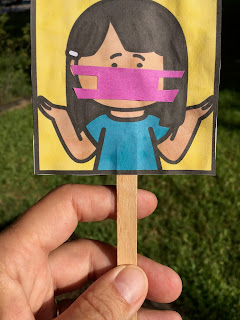I AM SO THANKFUL THAT BARBARA GRUENER IS MY FRIEND! HER SEL (social emotional) IQ (intelligence) IS INCREDIBLE! SHE HAS SOME MEANINGFUL AND INSIGHTFUL STRATEGIES TO SHARE WITH US TODAY! THANK YOU, BARBARA!
One of our biggest roles as educators, parents, mentors, and caregivers is to help the children in our care to understand and embrace their emotions; one way that we can do that is by modeling and teaching emotional regulation, one of the five Core Competencies of Social and Emotional Learning as laid out by CASEL.
Co-regulating emotions can be a difficult albeit very important job, one that might more easily be done in person, face-to-face and heart-to-heart. Since many of us will be teaching remotely, we’ve created Emotion Pops and put them in our Virtual Classroom Survival Guide to help you foster emotional literacy in your littles learners.
Simply print the feelings faces onto card stock, cut them out, and attach them to a popsicle stick or tongue depressor to make an Emotion Pop. Glue the corresponding emotion word on the stick to help children learn to name the emotion, spell it, and use it to identify how they’re feeling.
TIPS For Using Emotion Pops:
These Emotion Pops will be the perfect addition to your morning meeting. Hold up an Emotion Pop and ask for a thumbs up from everyone who is feeling that emotion right now. Pause between feelings to validate using statements like, "Friends, it looks like seven of us are feeling happy right now." Then move on to the next feeling, again asking for thumbs up if this is something that they are feeling, then review: "So it looks like three of us are feeling sad today. I wonder what they might need from us as their friends." Move through to another feeling and continue to acknowledge that it’s a normal part of being human that feelings, which are actually a source of energy, visit us. It’s also important that children know that feelings can and will change throughout the day. Repeat the check-in until everyone has given a thumbs up to at least one emotion.
Teach students not to label feelings as good or bad, but rather to just accept them as they are. Encourage them to invite their feelings in and make friends with them. Let each feeling stay as long as it needs to. Ask students if the picture on the Pop matches the way their faces looks when that particular feeling is choosing them. Ask: How does it look on you when you’re feeling sad? Scared? Angry? Worried? Happy? Confused? Shy? Invite them to show you how that feeling looks on their face, then practice making the feelings faces together.
Make sure children know and understand that it's possible to have two or more feelings visit at once. To punctuate that point, use the blank Emotion Pops to encourage students to draw how their face looks and feels when that happens, like when you’re hungry and angry (hangry) at the same time.
Set time aside to talk about how our bodies express the feelings. What happens to our foreheads, eyes, mouths, jaws, cheeks, arms, hands, stomachs, feet when we're angry? How about when we're sad? When we're happy? How about when we're confused, embarrassed, scared or any of the other feelings?
Choose a feeling to be your focus feeling of the day. Watch for people who are feeling that way. Talk about what it takes to get all the way through that feeling. Think about a show, a movie, or a story when the character felt this feeling. Was it big or small? Was it easy or difficult? Was it soft or hard? What color was it? There are no wrong answers here, so set aside ample time to explore all of their emotions.
Emotion Pops are especially useful right now in helping children understand how to read emotions when a part of our faces is covered. Use the sticky part at the top of a Post-It note to make a fun face covering. Ask: Can we tell how someone is feeling just by their eyes and through their body language? Encourage students to explore how their own eyes look, what happens to the muscles in their forehead and brow, how their cheeks look and feel, what their shoulders do, how their hands feel, how their stomach feels through all of the emotions, to foster emotional regulation as well as to elevate empathy.
Use Emotion Pops for empathy development by asking when they've seen someone else going through that feeling. Maybe it was during a read-aloud; research shows that reading fiction helps elevate empathy. Ask: What happened in the story? How was the character feeling? How could you tell? What was it like for that character when sadness (or whatever feeling you’re discussing) visited? What did that character want or need while that feeling was visiting? What do you want or need when you’re having a similar feeling?
When you’re back in a classroom again, you could laminate a set of the Emotion Pops and put them on an O ring in a Calming Corner so that your students have access to them as they work to understand their emotions. They could also be put onto a lanyard to make them portable for when a student who might need them travels to another part of the school for specials class,

I know that you'll definitely want to check out Barbara's book and blogspot!

https://corneroncharacter.blogspot.com/p/my-book.html



